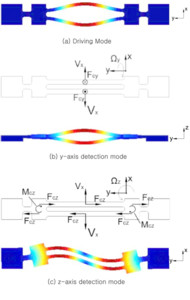A Study of the Effects of Mounting Supports, and Dissipation on a Piezoelectric Quartz Double-Ended Tuning Fork Gyroscope
A COMSOL model of a piezoelectric quartz double ended tuning fork gyroscope was implemented. The gyroscope has two detection modes; the first mode detects the angular velocity about a z-axis perpendicular to the tuning fork plane (x-y plane), while the second mode detects the angular velocity about a y-axis that is the longitudinal axis along the length of the tuning fork. Eigenfrequency analyses with geometric parameters were performed to maximize the sensitivity of the gyroscope. Frequency response analyses were used to simulate the response of the gyroscope to angular velocity about its z-axis. The Coriolis forces were treated as body forces in the COMSOL model. The sign and magnitude of the change in charge at the detection electrodes are proportional to the sign and magnitude of the angular velocity of the gyroscope. A sensitivity analysis was performed for the detection of z-axis angular velocity as a function of the silicon rubber adhesive thickness. The adhesive height would affect the production yields of this gyroscope.

Téléchargement
- yong_presentation.pdf - 1.03MB
- yong_paper.pdf - 0.8MB
- yong_abstract.pdf - 0.36MB
